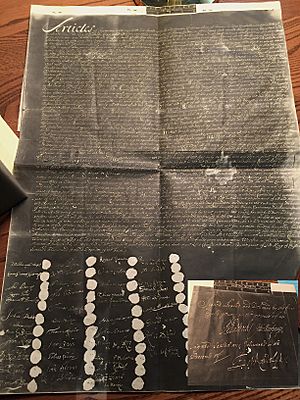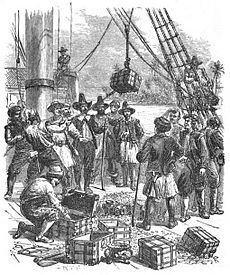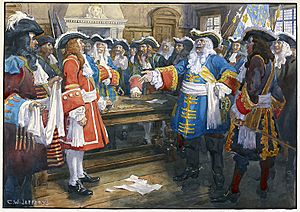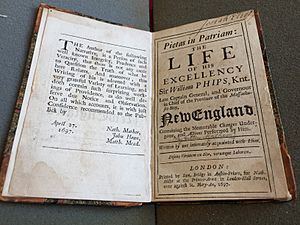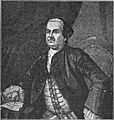William Phips facts for kids
Quick facts for kids
William Phips
|
|
|---|---|
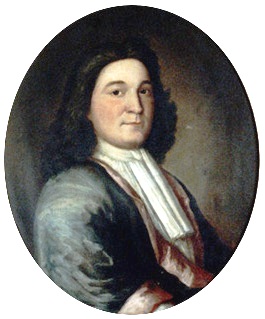 |
|
| 1st Governor of the Province of Massachusetts Bay | |
| In office May 16, 1692 – November 17, 1694 |
|
| Monarch | William III and Mary II |
| Lieutenant | William Stoughton |
| Preceded by | Simon Bradstreet (as governor of the Massachusetts Bay Colony) |
| Succeeded by | William Stoughton (acting) |
| Personal details | |
| Born | February 2, 1650/51 Nequasset (Woolwich, Maine) |
| Died | February 18, 1694/95 (aged 44) London, Kingdom of England |
| Spouse | Mary Spencer Hull (married 1673) |
| Signature | |
| Nickname | The New England Knight |
Sir William Phips (born February 2, 1651 – died February 18, 1695) was an amazing person from Maine. He started as a shepherd boy and became a ship builder, a ship captain, and a famous treasure hunter! He was the first person born in New England to be made a knight. Later, he became the first royal governor of the Massachusetts Bay Colony. Phips was well-known for finding a huge treasure from a sunken Spanish ship. He is also remembered for his role in the Salem Witch Trials, which he eventually stopped.
Contents
Early Life and Adventures
William Phips was born in a small settlement in Maine on February 2, 1651. His father died when William was only six years old. He grew up without much schooling.
Phips worked as a shepherd until he was 18. Then, he became an apprentice to a ship's carpenter for four years. Even though he didn't go to school, he was very smart.
After his training, Phips moved to Boston. He continued to use his skills in building and repairing ships. In 1674, he married Mary Spencer Hull. They seemed to have a very happy marriage.
In 1675, Phips opened his own shipyard in Maine. It was successful, building many small boats. In 1676, during a war with Native Americans, his shipyard was destroyed. Phips used his large merchant ship to rescue local settlers. He lost his business but became a hero in Boston.
The Hunt for Sunken Treasure
In the early 1680s, Phips started looking for treasure in the Bahamas. He was the captain of a ship called the Resolution. He searched for sunken Spanish ships. This trip was profitable, and Phips became known for "continually finding sunken ships."
A Royal Treasure Mission
In 1683, Phips traveled to England. He met with King Charles II and a high-ranking navy official, Sir John Narborough. This was a big deal for someone from humble beginnings like Phips.
The King gave Phips command of a warship, HMS Rose of Algiers. His mission was to hunt for treasure. However, Phips and his crew had to pay for their own expenses. They would only get paid if they found treasure. The King would get 35% of any treasure found. This was a risky plan!
A Difficult Journey to Boston
Before Phips could sail, he was given another task. He had to take Edward Randolph, a royal official, to Boston. Randolph was trying to change how the Massachusetts colony was governed. The King wanted a warship there to show power.
The journey was tough. A royal official named John Knepp was also on board to watch Phips. Knepp often complained about Phips and the crew. He thought Phips was not proper because of his background. But Phips was a skilled sailor, crossing the Atlantic very quickly.
When Phips arrived in Boston in October 1683, he used his ship to show the King's authority. He made other ships salute the King's flag. This caused some trouble with the local government. Phips was trying to follow the King's orders, but his loyalty was also with Boston.
After a few months, Phips left Boston in January 1684. He continued his treasure hunt in the Bahamas. He found some mutiny among his crew and left them in Jamaica. He didn't find much treasure there because other hunters had already been through the area. However, he gathered important information that would help him later.
Striking Silver and Gold
After returning to London in 1685, Phips convinced new investors to fund another treasure hunt. This time, the expedition was well-funded. Phips chose two ships, the James and Mary and the Henry of London. He carefully picked strong anchors and chains to keep the ships steady near the reefs.
Phips sailed in September 1686. In January 1687, his crew found the wreck of a Spanish ship called Nuestra Señora de la Concepción. It had sunk in 1641. Over the next few months, divers brought up tons of treasure: silver coins, silver bars, and jewelry.
Phips was careful to avoid mutiny. He promised his crew a share of the treasure, even if he had to pay them from his own portion. He brought the treasure safely back to England.
The treasure was worth over £200,000! Phips received £11,000 for himself after paying his crew. This was a huge amount of money at the time. Phips became a hero in London. Some historians believe this find helped create new companies and even the Bank of England.
In June 1687, King James II made Phips a knight. He also appointed Phips as the Chief Sheriff of the Dominion of New England.
A Return to Boston
Phips returned to Boston in the summer of 1688. He was welcomed as a hero by the people. However, he did not get along with the current governor, Sir Edmund Andros, or Edward Randolph. Phips quickly sided with the people of Massachusetts who opposed Andros's rule.
After only six weeks, Phips sailed back to London. He joined with Increase Mather, a powerful minister, to try and restore Massachusetts's old way of governing. Their efforts were successful. In 1689, a new King and Queen, William and Mary, took the throne in England. Phips returned to Boston in May 1689. He found that Andros and Randolph had already been arrested by the colonists in a revolt.
Becoming a Major General
In 1689 and 1690, French forces and Native American allies attacked towns in Maine. The Massachusetts government needed a strong leader to fight back. Phips, despite not having a military background, was chosen to lead an expedition.
On March 22, 1690, the General Court of Massachusetts made Phips a "freeman." This meant he could vote and serve in the government. He was also sworn in as Major General. This was a very important political step for Phips.
Port Royal Expedition
In April 1690, Phips led a fleet of seven ships and 700 men to Port Royal, the capital of French Acadia. The French governor surrendered quickly. However, Phips believed the French had broken the surrender terms by hiding valuables. He allowed his troops to take goods from the town and destroy the church. This made him a hero to the English colonists but was criticized by the French.
Quebec Expedition
After his success at Port Royal, Phips was given command of an even larger expedition against Quebec City. This was the capital of New France. The expedition had 34 ships and over 2,000 soldiers. However, they were short on ammunition and supplies.
The journey up the Saint Lawrence River was long and difficult. By the time they reached Quebec, it was already getting cold. Phips demanded the city surrender, but the French governor refused. Phips's attack failed. His land forces couldn't cross a river, and his ships' cannons couldn't reach the city's high walls. Many soldiers also became sick with smallpox.
This expedition cost the colony a lot of money. Phips even used his own money to buy some of the paper currency issued to pay the soldiers, which had lost value. He returned to England in 1691 to seek support for another attack on Quebec.
Governor of Massachusetts
In England, Phips again worked with Increase Mather. They helped create a new charter for the Massachusetts Bay Colony. This new charter made the colony much larger. It also allowed more men to vote, not just church members.
King William and Queen Mary appointed Phips as the first Royal Governor of the new Province of Massachusetts Bay. Increase Mather approved of this choice.
The Salem Witch Trials
Phips arrived back in Boston on May 14, 1692. This was a Saturday, and Puritans observed the Sabbath strictly. Phips showed respect for their customs, delaying his official swearing-in until Monday. He promised to respect the old laws of Boston.
Unfortunately, Phips's arrival happened during the height of the infamous witchcraft accusations. Over 125 people had been arrested. On May 27, Phips created a special court called the Court of Oyer and Terminer to hear these cases. Increase Mather's choice for Lieutenant Governor, William Stoughton, became the chief judge.
The court quickly began trials. On June 8, the first person accused of witchcraft, Bridget Bishop, was executed. The court allowed "spectral evidence," which meant people could accuse others based on visions of their "specter" (spirit). It was very hard to defend against such accusations.
Phips seemed to stay out of the trials at first. He was busy building a new stone fort in Maine, called Fort William Henry, to protect the colony from French and Native American attacks. He was away for much of August and September.
When Phips returned in late September 1692, twenty people had been executed. Even his own wife was accused of witchcraft. At this point, Phips decided the Court of Oyer and Terminer had to stop. He ordered a new court to be formed that would not allow spectral evidence.
However, William Stoughton was again chosen as Chief Justice. In January 1693, Stoughton ordered more executions. Phips stepped in and pardoned all those who were condemned. Stoughton was very angry and left the court. After this, no more people were condemned to die, and most prisoners were released by May 1693.
Final Years and Legacy
Phips's decision to stop the witch trials caused problems for him. He lost the support of some powerful people, including Stoughton. Other officials in London also tried to replace him.
Phips faced many challenges as governor. He had disagreements with other colonial leaders and royal officials. He was accused of not following certain trade laws. These accusations were sent to London.
On July 4, 1694, Phips received an order to return to London to answer these charges. He spent the summer in Maine, securing a peace treaty with Native American groups.
Phips finally sailed for England on November 17, 1694. Before he left, he pardoned everyone who had been accused of witchcraft. This ensured they would not be tried again in his absence. He left Boston Harbor after sunset on the Sabbath, firing guns from his ship. This showed he was no longer worried about upsetting the Puritan leaders.
Phips arrived in London in January 1695. He was arrested on charges related to customs money. He was released on bail but soon became ill with a fever. Sir William Phips died on February 18, 1695, at the age of 44, before his case could be heard. He was buried in London.
Family and Legacy
William and Mary Phips did not have any children of their own. They adopted Spencer Bennett, who later took the name Spencer Phips. He grew up to become Lieutenant Governor of Massachusetts.
Phippsburg, Maine is named in honor of Sir William Phips.
Images for kids


